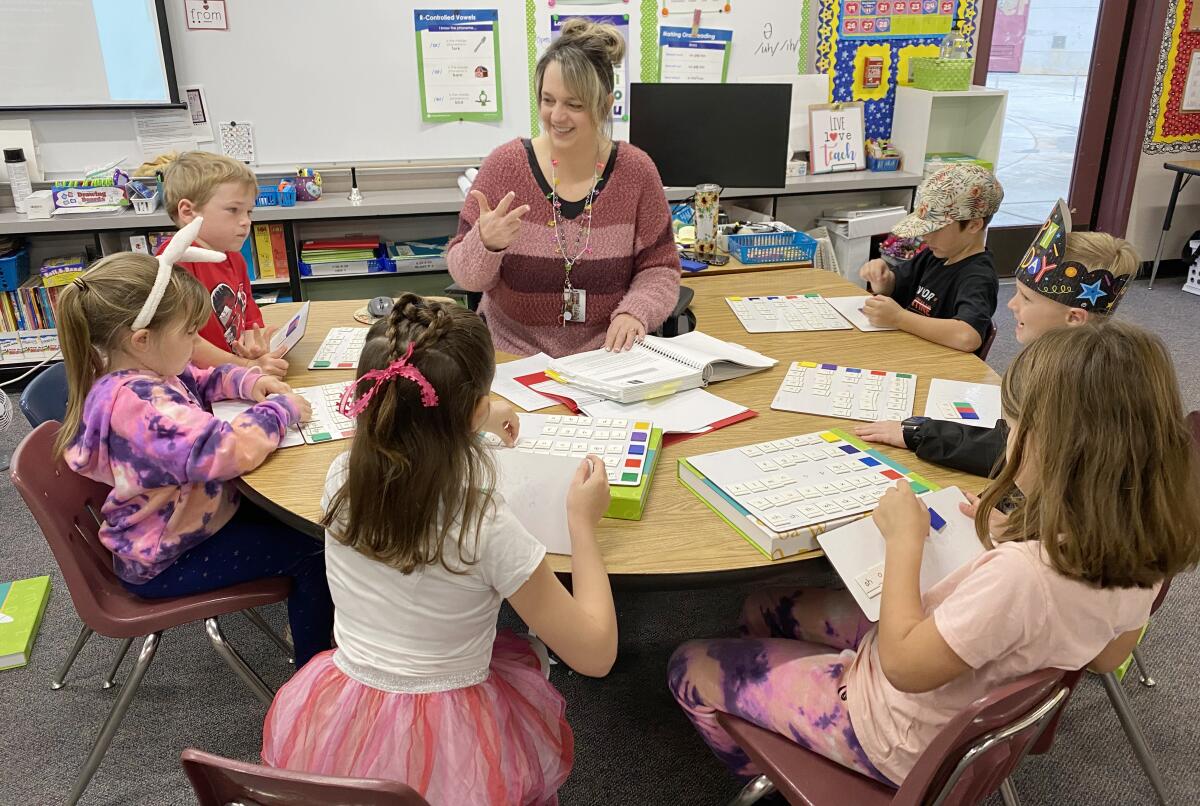Stanford study wades into reading wars with high marks for phonics-based teaching

- Share via
Test scores at 66 of the state’s lowest-performing schools strongly outpaced similar schools after educators adopted phonics-based instruction, offering some of the most compelling evidence to date that so-called science of reading methods are effective, a Stanford study concluded.
In science-of-reading practices, students are taught to use phonics, build vocabulary, pronounce words and read aloud, as well as develop an understanding of what they they read. The results of the Stanford study released Monday come as the nation’s educators wrestle with how to improve poor reading skills, especially among Black and Latino students and those from low-income families, a longtime problem made worse by the COVID-19 pandemic.
California is among 32 states and the District of Columbia that have passed laws or installed new policies since 2013 that rely on science-of-reading practices. And the new study lends support to this trend.
“Part of what is really encouraging about these results are gains in schools that have been chronically low performing,” said researcher Sarah Novicoff, who put together the study with professor Thomas Dee, an expert in education and economic data.
At one participating Los Angles Unified school, Principal Ramon Collins said reading attainment at the Young Empowered Scholars Academy in South L.A. was simply unacceptable, despite a hard-working, dedicated staff. In the year prior to the pandemic, in English language arts, 77% of the school’s students tested as far below proficient — the lowest category. In 2022, when testing resumed, that number worsened to 85%. But last year, that number dropped to 64% — a vast improvement, even with much work yet ahead.
Science-of-reading advocates are continuing to gain ground with policymakers compared with the rival “whole language” approach, which, in general, de-emphasizes phonics.
Whole-language instruction relies on learning words and phrases as they are encountered in readings and class discussions. Proponents of that approach insist that the joy of reading must not be subjugated to the mechanics of reading. Some dismiss phonics as boring and unnecessary, preferring instead to surround children with books and engaging content — such as a story with an exciting adventure, a narrative from history or captivating science.
Billions of dollars in state and federal pandemic relief have yet to pay academic dividends with K-12 students, although officials remain optimistic.
In examining the results of California public school data, the researchers concluded that, over a two-year period, the science-of-reading methods resulted in achievement gains equivalent to one quarter of a school year — compared with similar schools that were not using the approach.
This success is important, the researchers noted, because evidence supporting the science of reading is not as conclusive as some proponents would have it. These new findings, they add, also underscore the need to do more than simply train teachers to use phonics.
“This is about giving schools the support that they need to actually get better, not just telling them: ‘Hey, get better,’” Novicoff said. “So that means giving money, It means giving training. It means giving oversight. And this program did all of those things, not just curricular change.”
Math learning also benefited from the uptick in reading skills, improving by the equivalent of more than a month of extra learning compared with similar schools.
“Those programs were able to insulate schools partially from the effects of the pandemic and were able to help these low-performing schools actually improve,” Novicoff added.
The researchers also examined the comparative dollar value of the reading approach and concluded that the science-of-reading project provided 13 times more value for the dollar than simply supplying more funding. Educators have perpetually struggled for cost-effective reforms, given that student needs are great and financial resources are typically limited.
Although student progress was monitored regularly, the study had to rely on data that also were available for non-participating schools, so researchers examined results from the state’s standardized tests for third-graders. Third grade is the earliest grade tested by the state. The reading program itself is intended to benefit students from transitional kindergarten — age 4 — through third grade.
As part of the reading initiative, school staff were able to receive extensive training, ongoing coaching, instructional materials and diagnostic tools. Typical support for students included tutoring and after-school programming; family support included parental outreach and training. Schools had to involve staff and families in creating their plan and submit reports to the Sacramento Office of Education, which oversaw the work.
The reading initiative was funded through a 2020 court settlement, after a group of students and teachers sued California, blaming state officials for the poor reading skills of students. The plaintiffs had contended that students’ low literacy levels violated California’s constitutional mandate to provide all children with equal access to an education.
The settlement provided three years of funding, about $642,000 per school, to elementary campuses that included six in Los Angeles Unified, the nation’s second-largest school system. The Stanford research was not part of the grant funding.
Each school’s plan reflected local needs. One school on the Central Coast hired a new curriculum coach and a new parent liaison. That coach then trained staff on phonics, while the parent liaison conducted a Family Literacy Night.
A San Jose school used the grant to hire a part-time literacy coach who met with teachers weekly and also to purchase a new assessment and data system to monitor progress.
The principal at a Sacramento school hired a literacy coach and two instructional aides and purchased books for the school library with more culturally relevant material.
At the core of the work, students were taught the mechanics of reading as early as possible through matching single letters and groups of letters to the sounds they make, the essence of phonics. For example, the sound “K” makes can be spelled as “c,” “k,” or “ck,” as in duck, or “ch,” as in chorus. Children also learn to blend the sounds of letters together to decode unfamiliar words.
Supporters say proposed state K-12 framework will make higher-level math accessible to more. Critics contend it will make poor math outcomes worse.
Collins of YES Academy said teacher training and parent involvement have been essential.
“When the teachers learned the science of reading, and we put our minds collectively around that, that’s when the data starts to move into the right direction,” Collins said. “That’s when more students become readers and more students begin improving their reading. That was really what we focused on. Everything was literacy: reading, writing, listening, speaking. We wanted to build that.”
The school also brought parents into the process.
“We’ve had literacy nights,” Collins said. “During our interventions, we meet with our families, and we share with them the science-of-reading practices, so they can help at home. I speak about the phonics instruction, the word recognition.... It’s very transparent: This is what your students are learning in class. And this is the practice that they need to have at home.”
Ultimately, schools are imperfect laboratories because it’s difficult to isolate the effects of one effort from another. At YES Academy, for example, there also was a push for better attendance.
“Student attendance data was very instrumental,” Collins said. “We wanted to make sure that students were in seats. We understood that if students are not present, they don’t learn.”
The researchers are persuaded that the schools that received the grants accomplished meaningful advances.
In the wake of the pandemic, while reading scores were plunging in similar California schools, scores at the science-of-reading schools held steady. The six participating schools in L.A. Unified actually showed significant reading gains, although about 6 in 10 students remain well below state reading standards.
During this period, all California schools were flooded with federal and state resources to recover from the pandemic — a time that resulted in lengthy campus closures, economic hardship and family disruption caused by illness and death. Academic setbacks hurt students who already were struggling the most. One measure, state test scores, declined to levels of about five years ago.
Officials responded to pandemic learning setbacks with record state and federal funding, which resulted in such efforts as tutoring, extended learning time, additional teacher training, higher salaries for school workers and increased mental health support. These efforts even included science-of-reading training outside the effort studied by Stanford. In L.A. Unified, a program called Primary Promise relied heavily on the science of reading.
Nationwide, the science-of-reading approach received an early boost from Mississippi, which saw test scores rise after the strategy was adopted there. However, it was accompanied by other reforms as well, including retaining students in third grade when they did not meet reading standards. The national testing sample that showed gains in Mississippi was administered to fourth-grade students.
“There is a lot of neuroscience and research in the field of psychology that suggests the science of reading should be effective,” Novicoff said. However, “in schools that face a wide range of challenges, including entrenched poverty, these results have not always held.”
L.A. Unified’s own path to these reforms, which Supt. Alberto Carvalho strongly supports, has been uneven. Since 1999, the district — and at least eight superintendents — have touted their adherence to phonics, which evolved into the science of reading. Many schools, however, have continued to struggle with poor reading scores, and teachers in the field report inadequate training and monitoring.
“The district rollout has been inconsistent at best without adequate training for teachers,” said Pamela Cohen, a member of the L.A. Unified Dyslexia Workgroup. Teachers trained in the science of reading have found it “beneficial and eye-opening,” she said, but “I don’t think it is correct to say that all instruction in district schools [is] aligned with science of reading.”
She added a common complaint voiced by teachers: “The district is not allowing any program or approach to maintain long enough to have full impact. Teachers have whiplash and fatigue.”
The debate is not settled as far as everyone is concerned, with some parents and experts disagreeing strongly over an emphasis on phonics.
“Back in the early 1980s phonics was HUGE,” wrote parent Denise Oblander Reardon in an online post in the Facebook group Parents Supporting Teachers. “I remember and detest those phonics workbooks we had to use in 1st & 2nd grade. I’m not a teacher. I would have preferred other ways of learning to read.”
Many teachers have traveled individual paths on this topic.
“When I first start teaching, I really was more interested in the whole-language model that builds students love of reading first and grammar/phonics later,” said one L.A. teacher who did not want her name used. “This is how I learned, but I think it doesn’t work for 95% of kids, in my experience.”
More to Read
Sign up for Essential California
The most important California stories and recommendations in your inbox every morning.
You may occasionally receive promotional content from the Los Angeles Times.
















